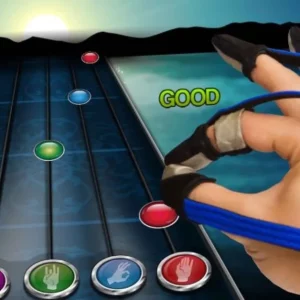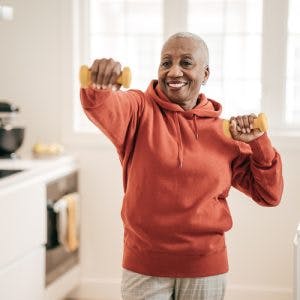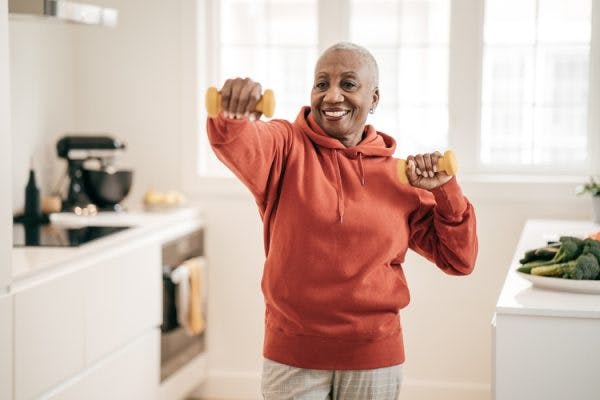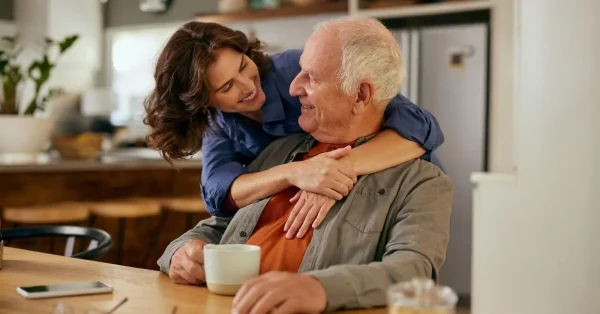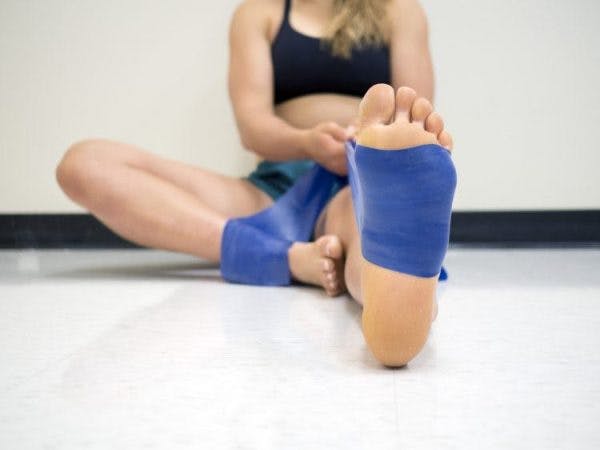Although flexor synergy patterns after stroke can be frustrating to deal with, they may be a sign of improvement. Also called flexion synergy patterns, these synergistic movements result from multiple muscle contractions that are triggered at once. For example, if you try to move your shoulder, your elbow and wrist might contract as well.
While flexor synergy can be a sign of recovery, this can also inhibit movements and daily activities such as reaching and self-care. However, there is hope to improve overall function through consistent rehabilitation. To help you better understand flexor synergy patterns, this article will explain the cause of synergistic movements and how to work through them.
What Are Synergy Patterns?
Coordinated muscle movements are a result of different muscle groups working together. These movement patterns are called synergies, and are responsible for muscle contraction and motions that appear smooth and controlled.
To complete a successful movement, two things must happen at once:
- The agonist muscles (the muscles that initiate the movement) must contract.
- The antagonist muscles (the muscles that inhibit the movement) must relax.
The brain is in charge of coordinating these movements, making sure the muscle groups do not accidentally conflict with each other. It does this by sending inhibitory or excitatory signals to the right muscle groups so they contract in a way that is synchronized and efficient.
For example, to pick up a fork, the triceps must activate to extend your arm, which means your bicep muscle must relax while this is happening. Otherwise, your elbow would bend at the wrong time and potentially drop the fork. The brain, therefore, will send signals to your bicep, telling it to relax so you can extend your arm with ease and complete the desired motion.
After a stroke, however, your brain’s ability to send the correct signals to the muscle groups may be inhibited. This creates difficulty activating single muscle groups, meaning multiple muscle groups may fire at once instead of individually. As a result, these synergies become mixed up and strange or frustrating patterns can occur.
What Flexor Synergy Patterns After Stroke Mean for Recovery
Flexor synergy patterns after stroke are closely related to spasticity, or involuntary muscle firing. Spasticity occurs when there is a misfiring of signals between the brain and muscles, causing muscles to contract involuntarily, or spasm. As spasticity increases, so may the presence of flexor synergy patterns.
Flexor synergy patterns of the upper extremity after stroke commonly involve these main movements:
- External rotation and abduction of the shoulder
- Flexion of the elbow
- Supination or pronation of the forearm
- Flexion of the wrist and fingers
In other words, whenever you try to move your affected arm, your shoulder will raise, your elbow will bend, and your wrist may turn until your palm faces up while your fingers curl into a fist. This can also occur as a reaction to sudden, unplanned movements like when you cough or sneeze.
In addition to the upper extremity, the legs can also be affected by synergistic movement after stroke. For example, the flexor synergy pattern for the lower extremity generally involves hip flexion and external rotation, knee flexion, and ankle dorsiflexion. This can negatively affect activities like walking, dressing, and getting in and out of bed.
While flexor synergy movements can be irritating, they may represent a sign that you are making progress in your stroke recovery. Following a stroke, many individuals experience hemiparesis or hemiplegia, which refers to weakness or paralysis of one side of the body. Transitioning from a state of minimal muscle tone to the presence of synergy patterns after stroke indicates an increase in neural firing and recovery.
The different stages and transition periods after a stroke are described in the Brunnstrom stages of stroke recovery. Although each survivor experiences a unique recovery journey, these stages can provide a guide for what you may expect during stroke rehabilitation.
The Brunnstrom Stages of Stroke Recovery and Flexor Synergy Patterns
The Brunnstrom framework involves seven main stages in the stroke recovery process, with flexion synergy patterns appearing in stages 2 and 3. In the first Brunnstrom stage, the muscles are in a state of flaccidity. This means that messages from the brain are not connecting to your muscles, leaving them temporarily paralyzed.
As you enter stages 2 and 3, however, the brain has begun to re-establish a connection to the muscles, and the muscles start to finally “wake up.” That is when synergy patterns can emerge. Flexor synergy patterns are your brain’s way of relearning how to control your muscles again.
It is important to note that while flexor synergy patterns can indicate recovery and be used in some compensation strategies, it is critical to continue pursuing dedicated rehabilitation to progress through this stage. If unaddressed, flexor synergies can worsen over time and lead to muscle shortening in the flexed position, called muscle contractures. The road to recovery is slow, but it is possible to help it along with consistent rehab techniques, which we will review next.
Treating Flexor Synergy Patterns After Stroke
The best way to overcome flexor synergy patterns after stroke is through repetitive and meaningful practice of stroke rehabilitation exercises. This helps activate neuroplasticity and rewire the brain, which can encourage and promote recovery after a stroke.
The more you move your affected muscles, the more your brain can create new neural pathways that will reestablish communication with muscle groups. As these pathways become stronger, muscle coordination will improve and normal muscle synergy can be restored. This highlights the importance of high repetition or massed practice. The more a skill is practiced, the more efficient that skill will become.
Of course, this can be hard to do, especially when movements are unnatural or difficult. That’s why your best option is to work with your physical therapist and occupational therapist to find the ideal approach. They will create a treatment plan to address your individual goals and maximize your independence.
Here are some examples of exercises you can do to overcome flexor synergy patterns:
1. Passive Exercises and Stretching
Passive range-of-motion exercises can help you maintain range of motion and may assist in regaining muscle control. During passive exercises, you can use your unaffected limbs to move your affected limbs through their full range of motion. This stretches the muscles, helps maintain joint mobility, and prevents development of contractures or a clenched hand.
If performing passive range of motion independently isn’t possible for you, a therapist or trained caregiver can help you perform these exercises. Even though you technically aren’t performing the motion yourself, passive range of motion will still stimulate the brain and rekindle the neural networks that help you move.
2. Sensory Exercises
Sensory stimulus plays a crucial role in synergistic movements. This sensory input is what allows your muscles to know how and where to move, which is why it is vital for stroke recovery and improving flexor synergy.
For example, the receptors in the muscles that send proprioceptive information help the brain determine where your joints are in space. This lets the brain choose which muscles it needs to activate to complete a movement. After a stroke, sensation can be diminished. Therefore, sensory exercises can help you restore normal sensation and improve your proprioception and movement as a result.
To help you get started, here are two helpful sensory exercises you can try at home:
- Joint sensation. Sit blindfolded on a chair and have a caregiver move your arm to several different positions. Try to identify where your arm is without looking.
- Fingertip touch. While still blindfolded, have someone touch each of your fingertips separately. Your goal is to correctly name which finger they touch. Then take off the blindfold and see if you were right.
Due to the brain’s neuroplasticity, the more consistently you stimulate your senses, the faster your brain will relearn how to interpret sensation and improve synergy patterns. Your physical and occupational therapists can give you more ideas on how to improve sensation and proprioception after stroke.
3. Active Range-of-Motion Exercises
Active exercises are the best way to increase proper synergy patterns and regain voluntary movement. Even if active motion is difficult and inefficient at first, persistence and daily practice is necessary to regain function and help resolve flexor synergy patterns after stroke.
Examples of active exercises include:
- Hand to opposite knee. Sit on a chair and lean against the chair’s back, holding your head up high. Move your affected hand from your lap to your opposite knee.
- Hand to chin. While sitting in the same position, move your hand from your lap to your chin and back down. This gives you a chance to practice elbow flexion and extension.
- Diagonal arm raise. In sitting or standing, start with your arm straight and positioned at the opposite hip. Then raise the arm high while bringing it diagonally across your body to open up your chest and shoulder.
Again, when you first start these motions, you may not be able to do them correctly or efficiently. However, you are still activating neuroplasticity and promoting rewiring of important motor pathways, so do what you can and keep practicing.
Over time, these active range of motion exercises may become less challenging, and you will be able to progress to more involved strengthening activities with the guidance of your rehab team. Strengthening the opposing muscle groups can help inhibit flexor synergy patterns and improve function with daily activities.
See all active stroke rehab exercises »
4. Weight-Bearing Exercises
One excellent way to improve proprioception and decrease spasticity is to perform weight-bearing exercises with the affected limb. Placing some of your body’s weight through your upper extremity can help provide a low-load, long-duration stretch to the muscles.
Additionally, weight-bearing provides proprioceptive input to the receptors within your joints and can also reduce neuron excitability, decreasing the presence of spasticity or a flexor synergy over time.
Some examples of weight-bearing exercises for the upper extremity include:
- Seated weight-bearing through the wrist. While sitting, place your hands flat on the chair or bed next you. This can also be done with help from a caregiver. Slowly shift weight from side to side, gradually increasing the weight placed through your affected arm.
- Prone weight-bearing on elbows. With assistance if needed, lay on your stomach with your forearms on the surface below you for support. Try to press your chest up tall, keeping your weight on your forearms. If able, slowly shift your weight from side to side.
5. Manual Techniques and Modalities
In addition to passive and active exercises, your therapist may use other techniques to help address your flexor synergy pattern after stroke. For example, they may use manual strategies to help engage the desired muscle groups, such as tapping the muscle or providing other sensory feedback.
They can also perform manual techniques to help decrease tone or spasticity. This might include low-intensity passive range of motion, prolonged stretching, and joint approximation or compression. Additionally, your therapist can help you achieve weightbearing positions to help reduce flexor synergy patterns and encourage proprioceptive feedback while giving you the support you need to complete the activity safely.
Another common technique used in therapy, electrical stimulation, can be a valuable tool to combat flexor synergy patterns after stroke. This modality is applied via electrodes placed on the skin, sending electrical impulses to the desired nerves and muscles. This electrical stimulation can elicit muscle contraction to encourage appropriate muscle synergy, decrease spasticity, and improve arm function.
Flexor Synergy Patterns After Stroke: Key points
Flexor synergy patterns are common after stroke and cause multiple muscle groups to fire at once. Although this can be a sign of improving communication between your brain and muscles, flexor synergies can be uncomfortable and can lead to complications if not addressed.
Fortunately, you can overcome flexor synergy patterns with consistent practice of therapeutic rehab exercises. These movements help rewire the brain and allow you to isolate the correct muscle groups, improving coordination and fluidity of movement. These improvements take time, high repetition, and consistency, but your therapy team is there to help support you during your recovery journey.
With enough practice, you can regain voluntary control of your muscles and move your arm smoothly again. We hope this article has helped explain flexor synergy patterns after stroke and the different treatments and techniques available to help you maximize your recovery.



